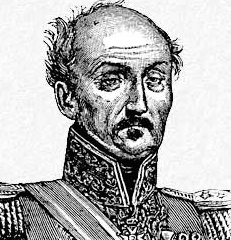General Adrien Jean Baptiste Amable Ramond du Bosc Dutaillis

Born: November 12, 1760
Place of Birth: Nangis, Seine-et-Marne, France
Died: February 4, 1851
Place of Death: Paris, France
Arc de Triomphe: DUTAILLIS on the east pillar
Pronunciation:
Joining the engineers in 1778, Adrien Jean Baptiste Amable Ramond du Bosc Dutaillis joined the volunteers of Nassau-Siegen in 1779. He went on to serve on the sea for the expedition to Jersey and then at the affair of Cancale. After the arrival of the French Revolution in 1789, Dutaillis was named a capitaine in the National Guard of Paris on July 17, 1789. In 1791 he joined the 14th Battalion of Light Infantry and in 1792 he began serving with the Army of the North. Seeing action, Dutaillis served at the Battle of Valmy and the Battle of Jemappes that autumn. He went on to serve at the action of Liége and then Verviers and he was wounded on March 2, 1793. That December the representatives of the people suspended Dutaillis for being a royalist.
In February of 1795 Dutaillis was reintegrated into the army and he was assigned to the Army of the Alps. In March he began to serve as an aide-de-camp to General Berthier and in April he was promoted to chef de bataillon. In 1796 Dutaillis joined the Army of Italy and he took part in General Bonaparte's successful campaign against Austria in Italy. That August he distinguished himself at the Battle of Castiglione and he was given the honor of taking the flags captured at Castiglione back to the Directory. Upon presenting the flags, Dutaillis was awarded pistols of honor. Returning to the Army of Italy, he next served at the battles of Arcola , Rivoli , and Bassano. In 1797 after the crossing of the Tagliamento and the action of Gradisca Dutaillis was sent on a special mission to deliver orders to General Joubert. During his mission he encountered a body of Tyrolese who had just repulsed fifty French soldiers. Without hesitation Dutaillis took six men and forced his way through, but he lost four men and his clothes were riddled with balls. In November he was promoted to chef de brigade and in 1798 he served with the Army of the Rome and the Army of the Orient. In 1800 Dutaillis served with the Army of the Reserve and he distinguished himself at the Battle of Marengo.
In 1801 Dutaillis was attached to the depot of war and in 1803 he was promoted to général de brigade and named chief of staff of the camp of Montreuil under General Ney. As the Grande Armée marched out in 1805, Dutaillis continued to serve as Ney's chief of staff for the coming campaigns. He served at Elchingen and Ulm in 1805 and then in 1806 he served at the Battle of Jena and he took the surrender of Magdeburg. In June of 1807 Dutaillis served at the combat of Guttstadt where his right arm was carried off by a ball. At the end of the month he was promoted to général de division.
In 1808 Dutaillis took a long leave and then in 1809 he was made available to Marshal Berthier with the Army of Germany. That May he was named commander at Munich and then later in the year he was named commander at Erfurt. In the meantime Dutaillis was recognized as a Knight of the Iron Crown and he received the Grand Cross of the Military Order of Bavaria. He returned to Paris where he continued to serve with Berthier and in 1810 he served on a mission to Germany. In 1811 Dutaillis was a candidate of the department of Seine-et-Marne for the senate but he was not chosen.
Dutaillis was named military commander at Warsaw in April of 1812. As the army withdrew from Poland he was reassigned to Torgau and after Narbonne's death in November of 1813 he became governor of Torgau. Dutaillis held Torgau until December 26th when he was forced to surrender to the Coalition forces. Taken prisoner at the surrender, he was returned to France after Napoleon's abdication in 1814. Dutaillis was put on non-activity but also named a Knight of Saint Louis. He officially retired in October of 1815.
Bibliography
Related Pages:
Updated August 2020
© Nathan D. Jensen